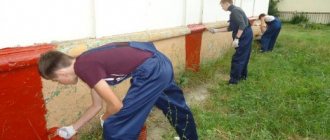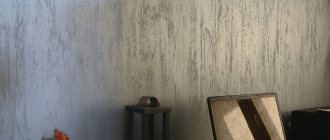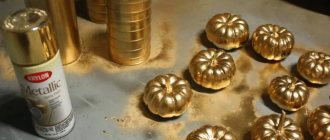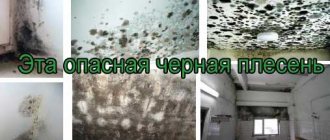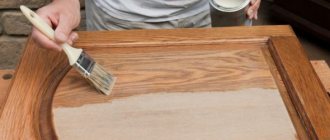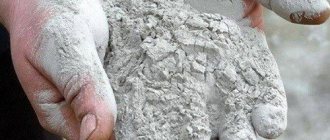A layer of paint applied on top of plaster or any porous surface can also protect the foundation from external temperature and mechanical influences, as well as give an attractive, unique and aesthetic appearance to the structure.
Finishing the base with paint has its own nuances, so you need to be able to choose it correctly. How best to do this, what solvents and additional components you will need to use during the work process, you can learn from the proposed article.
Materials and tools for work
Before you start painting the foundation of a cement house, you should prepare everything you need.
To apply paint you will need:
- different brushes and rollers with bristles, as they are more resistant to wear from contact with concrete;
- wire brush, water hose;
- shovel;
- individual protection means.
To prepare the surface for painting, you will need cement to seal cracks and chipped areas. In addition, it is necessary to prepare a primer mixture to reduce the absorption of the concrete surface, thereby reducing paint consumption.
You will also have to decide what is the best way to paint the foundation of the house, calculate the need for a paint composition, taking into account the characteristics of the material and its approximate consumption.
Carrying out painting work
All work can be done on your own if you follow certain recommendations. The algorithm of actions is as follows:
- The concrete surface is first cleaned of mortar residues and contaminants using a stiff brush and water supplied under pressure. After this, the foundation should dry well;
- using a shovel, the turf is removed in front of the foundation base, and a blind area is planned;
- The chips are processed and puttied with a cement-based solution. It should be left for at least a day so that the liquid solution dries and becomes suitable for applying the second layer;
- a special primer is applied with a roller, filling the pores of the base and improving the adhesion of the paint to the concrete;
- the coloring composition is diluted to the required consistency with solvents or water, filtered to remove any remaining lumps;
- Rollers and brushes are used for application; for large areas it is better to use a spray gun.
Requirements for paints
Today, ready-made latex paint for foundation plinths is produced in the form of a concentrated composition that requires dilution with water or solvents in a certain proportion. It is important to read the recommendations on the packaging.
The principle of interaction between paint components and foundation materials is clear - to create maximum adhesion for the protective film. It should also:
Summarizing all these factors, it becomes clear that the ideal paint for a concrete foundation should be, at a minimum, frost-resistant, moisture-resistant and vapor-permeable. Additional properties are environmental friendliness, practicality and durability.
If there is a large supply of paint left, you can use it to treat other surfaces that require protection:
- Blind area;
- Facade decor;
- Fences and fences;
- External stairs;
- Verandas and gazebos;
- Garden path edges;
- Poles for lighting gardens and areas.
House foundation painting technology
Before painting an outdoor concrete foundation, it is important to thoroughly clean it of mold and mildew, moss and dirt, and weed out adjacent vegetation.
Basic materials for painting:
- Cement or plaster mixture for sealing cracks;
- Good sealant;
- Basic dye;
- Deep penetration primer mixture.
Surfaces are painted in dry, cloudy weather.
Briefly, the process of self-painting looks like this:
- Removing soil from vegetation.
- Cleaning the foundation with a stiff brush.
- Elimination of defects and sealing of cracks, treatment with sealant.
- Washing the surface followed by drying.
- Primer treatment.
- Painting the foundation with the first layer. After drying, re-process.
Surfaces are painted in dry, cloudy weather.
As you can see, today there is no shortage of proposals for painting the foundation. A large assortment of paint and varnish products provides ample opportunity to choose the optimal composition for maximum protection of the base of any building.
Materials and tools for work
For craftsmen who have confident painting skills, painting the basement of a house will not be difficult. You will need standard tools:
- Bayonet shovel for cleaning dirt;
- A hard metal brush for cleaning off deposits;
- Paint brushes and roller with attachments;
- Construction spray gun;
- Set of spatulas (trowel).
Kawabanga!
Insulation of a concrete floor in an apartment The set of tools may vary slightly, depending on the conditions of the work and the degree of neglect of the old foundation. A hose for rinsing under running water, brooms and brushes may be useful.
Should you opt for a high base?
After reviewing the information, we can conclude that a high base is a good investment in the durability, durability, strength and beauty of the future home.
The large number of existing advantages of such a design allows us to have no doubt about its importance and benefits
It combines functionality and aesthetics at the same time. Both of these factors are undoubtedly important. However, before making a specific decision on the height of the basement structure, it is worth assessing the parameters of the future house, since a high basement is not always necessary. You should focus on individual characteristics in each specific situation.
Let's look at the properties of paints for concrete
Acrylic paints
Silicone paints
Due to the high degree of elasticity, no additional surface tension is created, which significantly extends the life of the paint. In addition, it perfectly withstands the influence of ultraviolet radiation, without fading and maintaining its attractiveness.
Epoxy paint
The cost of this type is quite high, but with the help of this material it is possible to protect the base not only from atmospheric influences, but also from mechanical damage.
Polyurethane paint
To achieve maximum durability, it is necessary to apply the paint in two layers. The second one needs to cover the surface after the first one has dried. Within a week the base will gain mechanical strength, and after two weeks it will become resistant to aggressive influences.
Silicate
However, there are also disadvantages to silicate paints. Among the main ones are a long drying period and a low coefficient of vapor permeability.
Alkyd
Despite the high resistance to ultraviolet radiation, it is necessary to periodically renew the surface. This should be done approximately once every three years.
Oily
This paint has a very attractive appearance and is consumed very economically, while the cost of such a paint coating is quite reasonable, which makes it not only reliable, but also profitable.
Cement
Any of the listed paint and varnish materials can make the base attractive, while providing it with additional protection from the influence of external factors. But this is only possible if the application technology is followed.
The feasibility of using paint for the foundation of a house
Basement paints and varnishes are suitable for any surfaces that are a continuation and wall of the foundation base.
We are talking about different types:
- bricks,
- concrete,
- wood,
- metal
Brick and concrete are well strengthened and then insulated with heat insulators, on top of which a layer of plaster is necessarily applied. Painting this layer will reliably protect the surface from destruction, precipitation, fungi and mold.
Modern domestic and foreign manufacturers produce various types of paints and varnishes. The main feature of paints is that they:
- Reliably adhere to surfaces.
- Protect and improve the performance of the foundation.
- They are water and vapor permeable.
- Gives the walls a designer look.
- They are environmentally friendly and safe.
Suitable for concrete and brick walls:
- latex,
- acrylic,
- alkyd,
- polyurethane paints and varnishes.
The composition of each type is characterized by:
- Instant drying.
- Reliability and durability.
- Resistant to mechanical stress.
- Impermeable to water and steam.
- Ease of application.
- Resistant to humidity, temperature and external pollution.
- Economy of quantitative consumption.
To achieve the listed properties, applying just one layer is sufficient. But in some cases, experts recommend covering the surface with several layers.
The peculiarity of any paints is that they must be compatible with the material from which the base is made. Experienced craftsmen recommend choosing it together with a primer, and both substances should complement each other. The primer penetrates into the pores of the wall, fills them, thereby significantly reducing the consumption of painting material.
A number of enamels are also suitable for wooden and metal surfaces:
- oil,
- alkyd,
- fireproof.
They especially need painting. Paint protects wood from destruction and at the same time kills fungi, and metal from rust and further corrosion. The fresh facade of the house adds uniqueness to the structure and creates the effect of a good mood.
Before applying the paint, the surfaces are carefully prepared and primed. A layer of plaster, putty and primer applied to any surface has a thermal insulating effect, but it can also be covered with a layer of paint.
The outer coating forms a protective film that prevents the basement wall from interacting with the aggressive external environment, precipitation and humidity. The choice of paint color depends on the owner's project plan and personal preferences.
Epoxy paints are especially valued in the construction market . The new product has won the hearts of many users due to its composition, brilliance and quality.
Technology for painting the base
When paint for facades and plinths has been selected, you should study the features of its application. Manufacturers usually indicate the characteristics of coloring using the composition. But there is also a general technology for applying paint to the surface.
Surface cleaning
Sealing cracks and leveling the surface
Sealing cracks
If you need to create a more durable solution, you can add a plasticizer to it. 2 days after embedding, they begin leveling the base. Further procedures are carried out after the solution has completely dried.
Surface primer
The primer is applied to a dry surface. It is important to coat the plinth thoroughly so that the compound penetrates into every crevice. This guarantees perfect paint adhesion. You can cover the wall with two layers of primer.
Primer work
This is due to the fact that after the first application the primer is almost completely absorbed by the base. You can coat the base with a primer using a brush or roller.
Kawabanga! Features of finishing a house made of aerated concrete
Painting the base
Final coloring
Each subsequent layer is applied after the previous one has dried. Typically, the time when the base can be coated with the next layer is indicated by the manufacturer.
A painted base is not only beautiful, but also reliable. Correctly selected composition and adherence to the technology of its application will help prevent damage to the surface from the influence of external factors.
In addition, a large abundance of paints and varnishes makes it possible to embody original design ideas, where the base will become an integral element of the overall picture of the facade.
How much does it cost to paint the basement of a house?
The price will depend on the initial condition of the structure, area, materials and work used.
If you take painting in its pure form, then the cost of paints starts from 50 rubles. per kilogram up to 400-500 rubles. The primer will cost from 20 to 200 rubles. per liter We need to add another 2000 -3000 rubles. on tools and colors.
Works are priced per square meter:
- Cleaning – 40 rub./m2.
- Primer – 30 RUR/m2.
- Painting one color at a time – 45 RUR/m2.
- Painting in different colors at a time – 90 RUR/m2.
The paint reliably protects the surface of the base from moisture and destruction, and allows the material to “breathe.” With the help of colors and textured compositions, you can imitate various coatings, from “brick-like” to a bright glossy base.
Similar articles
- Do-it-yourself painting of the facades of private houses
The surge in popularity of siding facade coverings only briefly reduced interest in such a traditional finishing method as painting facades. Read more - Technology and secrets of painting façade bark beetle
paint
the surface of decorative plaster only after it has completely dried, which on average is about 48 hours. Read more - How to paint OSB board for exterior decoration on the facade...
And you can start
painting
.
...
It’s worth choosing what
to paint
the OSB board on the facade of the house with, mastering the technology and you can start finishing. Read more - Painting a wooden house
You can
paint
a wooden house at temperatures above zero degrees;
To prevent the paint from blistering, it is necessary to paint
only well-dried wood;
Paint
in the longitudinal direction - according to the structure... Read more - Painting aluminum or galvanized profiles
How
to paint
galvanized steel - in the workshop.
...
I wouldn’t
paint
any of the finishing materials, if only because the paint will start to wear off in any case and I’ll have to spend extra time on painting again. I do not need this. Read more - Painting the outside of a timber house
Using a variety of
coloring
compositions, you can solve several problems at once: protect your home from harm that the external environment can cause. Read more
The best paint for the base
When deciding how to paint a concrete foundation, you should take into account the surface material of the building structure, local climatic conditions, cost, durability, surface application technology and the desired color shade.
How to paint the foundation of a house for a beautiful appearance? Depending on your financial capabilities, use alkyd or polyurethane paints. Among the colors and textures offered on the market, you are sure to find the best option.
To coat surfaces made of porous materials, silicone paints must be used. No other paint can provide them with a higher level of protection.
Do not forget about preliminary priming of the surface. This operation improves surface adhesion and ensures the durability of the paintwork. Therefore, when purchasing paint, do not forget to purchase the appropriate primer.
Painting the foundation of a house - what does it give?
The basement is the foundation of the house, an above-ground continuation of the foundation. The peculiarity of the foundation is that it will “grow” out of the ground, having direct contact with the acid-base environment of groundwater. No matter how high this level is, it is subject to significant stress from temperature changes and precipitation. The situation becomes more complicated when there is no blind area or sidewalk adjacent to the wall.
Suitable paint for the base protects it from the destructive effects of weather and climatic factors. It is not washed off, penetrating deeply into the porous structure of the concrete base, thereby forming a kind of protective impregnation of the surface. When you paint the base to look like stone yourself, the aesthetic characteristics of the outer part of the foundation also improve. Without base paint, the building loses not only its attractiveness. Premature “aging” and destruction of the outer part of the base gradually leads to uneven subsidence of the house. It can be aggravated by soil movement processes, then cracking of the walls and foundation appears, and the building becomes unsafe.
Latex film is an additional protection for the foundation from the outside.
When thinking about how to paint the outside of a house's concrete foundation, it is important to understand what it does later. Particularly destructive is moisture that penetrates deep into stone or brickwork, which, when frozen, destroys the materials of the base. Coating the base and blind area with high-tech silicone or rubber paint will help delay the destruction of a private house, cottage or country house. Therefore, it is legitimate to worry about how to paint the foundation of a cement house. This is the first thing you need to take care of after completing the main part of the construction and installation work.
Suitable paint for the base protects it from the destructive effects of weather and climatic factors.
Today there is no shortage of specialized compounds for outdoor work. They will be shown in the nearest construction supermarket, they are in any catalog of paint and varnish mixtures. There are highly specialized and universal paints that can be used to coat any material:
- Natural and artificial stone;
- Brickwork;
- Ceramic cladding.
The owner of his own home only needs a little advice on how to paint his concrete foundation plinth to ensure maximum protection.
Today there is no shortage of specialized compounds for outdoor work.
Advantages and disadvantages
Any paint for foundations on concrete is reliable, which one is better for the material with which the base is lined, follows from the sum of its pros and cons. Each coloring composition has a number of positive characteristics; they are relied upon to a greater extent when choosing.
Most specialized foundation paints for concrete have the following important qualities:
- Aesthetics, some formulations have improved properties;
- Large selection of color and texture variations of facade paints;
- Cost-effectiveness is not only an affordable price, it also extends the service life of the finishing cladding of the foundation;
- Ease of use (quick painting is guaranteed if all technological requirements for surface preparation are met);
- Possibility of working under a wide range of temperatures and humidity);
- The ability to change the appearance of the building if you want to update the house and give it a more attractive look;
- Most latex compositions are water-based and environmentally friendly; the vapor-permeable film is able to “breathe”, releasing excess fumes.
Painting your home's foundation also has its downsides. But the short service life and high cost of some imported mixtures are insignificant compared to their excellent properties.
Large selection of color and texture variations of facade paints.
Types and characteristics of paints for protecting the base
For the lower part of the building, it is recommended to use the following types of paint for the plaster plinth:
- acrylic, diluted with water;
- alkyd, based on natural and synthetic solvents;
- silicone based;
- epoxy;
- polyurethane.
Acrylic paints
Alkyd paint and varnish compositions
Silicone based paints
Epoxy paints
They are the strongest and most durable. Ensures complete sealing of the coating. They consist of an epoxy base, a coloring pigment and a hardener, which is added to the composition just before application to the surface.
Epoxy paint can protect the base not only from precipitation, but also from strong mechanical influences. The main disadvantage of the material is its high cost.
Polyurethane coloring compounds
Primers for outdoor work
The primer is selected taking into account the characteristics of the material from which the surface is made. Professionals recommend purchasing materials from one manufacturer. This guarantees their full compatibility and achievement of the best results. Also, when choosing soil, you should take into account the geographical and climatic characteristics of the region.
The surface must be primed several times: before filling cracks and immediately before painting. If the base is problematic, then you can use quartz soil to strengthen the surface. It has inclusions of quartz sand and helps seal cracks and prevent efflorescence.
For buildings located in cities, it is recommended to use acrylic primer, which is breathable. This primer is also suitable for rural areas. In addition, silicone-based primer can be used for country houses.
Instructions for painting the base
After selecting and purchasing paint with the appropriate primer, you can begin painting the surface of the basement of the building. They include the following steps:
- cleaning from dirt and mold;
- primary priming;
- sealing cracks and leveling the surface;
- second soil treatment;
- coloring.
Tools for painting work you will need:
- paint brushes, roller or spray gun;
- paint roller tray or other wide container;
- spatula, wire brush, hammer and chisel;
- trowel, grater and short plastering rule.
In addition, you should prepare a tool for possible mechanical removal of mortar residues and other contaminants.
Surface cleaning
Sealing cracks and leveling the surface
Before painting the base, it is necessary to repair the cracks and level it. Before performing this work, the base should be treated with deeply penetrating primer. This will bind any remaining dust particles and strengthen the concrete or brick surface.
Work on sealing cracks must be done with a cement-sand plaster mortar prepared in a ratio of 1:4. To improve the quality, it is recommended to add a plasticizer or liquid detergent to the solution.
Painting the base
Before painting, the surface must be treated with primer again twice and allowed to dry for 24 hours. This will strengthen the places where the leveling layer is applied.
Kawabanga! Paint for concrete outdoors: advantages of painting and choice of composition, step-by-step instructions for performing the work
Painting scheme with a spray gun.
Painting the foundation
Why is it necessary to protect the foundation, plinth
Painting the base will solve a large number of problems. Timely painting using the paint most suitable for the home allows you to:
- Provide additional protection for the base. The base is affected by many unfavorable factors. Treatment of the porous surface gives it additional strength and resistance to external influences. In addition, this finish is very easy to update.
- Create an additional protective layer that will retain moisture while allowing vapor to escape. This will significantly extend the life of the house.
- Simplify the care process. The basement gets dirty much more than the rest of the building. The right choice of paint will make it possible to clean it without much effort, as well as renew it if necessary.
- Hide minor defects and make the appearance of the house attractive. By using a combination of different shades on the base and facade, you can realize bold design ideas.
The base part will last for many years
A significant advantage of painting the base is the cost-effectiveness of such finishing. The cost of the paint is quite reasonable, and it will take a maximum of a day to complete all the work.
Types of paints for concrete
- high and low temperatures (and their differences);
- humidity changes;
- exposure to precipitation;
- UV radiation and air pollution.
You can choose a color to suit your taste
The paint for the base must withstand both the action of all these factors at the same time, and the intense impact of one of them, for example, constant sun rays on a sunny southern façade.
Coatings designed specifically for concrete include acrylic, silicone, epoxy, polyurethane, silicate and alkyd paints. Budget option - oil, cement.
Acrylic paints
They can be recommended for protecting concrete products, fiber-cement slabs and plinths from moisture. Given their low vapor permeability, acrylic paints are not suitable for silicate substrates and lime plaster.
Concrete that is to be painted with acrylic paint must be primed with a primer from the same manufacturer. In addition to creating a high-quality coating, this protects the surface from the penetration of moisture and salt.
Silicone paints
Epoxy paint
These materials require careful cleaning and surface treatment. Suitable solvents are esters, ketones, aromatic hydrocarbons and alcohols are used as solvents.
The influence of the atmosphere is manifested in the loss of gloss of the coating, but this feature does not weaken the anti-corrosion properties of the coating, which is very important for concrete paint for foundations.
Polyurethane paint
Due to its properties, it is ideally suited for exterior work and painting the foundation/basement.
Silicate
Schwyz – town hall painted with silicate paint
Silicate paint is considered very durable and weather resistant. Its service life significantly exceeds one hundred years. An example is the town hall in the city of Schwyz in Switzerland, covered with such a coating in the 19th century.
Painting with silicate paints requires skill and experience, since liquid glass destroys metal and ceramic tiles. So it is better to entrust painting work with this material to a specialist.
Alkyd
Oily
It should be applied to a completely dry, pre-primed base - concrete or plaster.
What materials to choose for finishing
Good paint for the base will extend the life of the base of any structure
Today manufacturers offer a lot of interesting things. This includes paints and varnishes that need to be diluted with plain water. There are options diluted with thinners and solvents. If you read the instructions carefully, it will say that at the same time as the paint for the base, you should also buy a suitable primer.
Only when these two components are chosen correctly and used together can you count on excellent results.
Choosing paint - what to buy
The basement has already been painted - the house now looks completely different
Paint today (including for the base) can be textured and smooth. This significantly expands design possibilities.
In detail, then:
Most often, acrylic paints are used for application to the base, which are diluted with water (this work is not just painting a wall, but there are similar aspects). This material is actually well suited for stone, brick or concrete surfaces. The materials are moisture resistant and have suitable vapor permeability. It is also worth noting frost resistance, excellent adhesion
The finished result does not fade - this is also good; You can pay attention to alkyd and polyurethane compositions. These paints are created using synthetic or organic solvents
They do not react to alkaline environments, nor to temperature changes. Ultraviolet, water, mechanical influences - all this does not play any role, you don’t even have to worry. This base paint for concrete will last a very long time - if it is applied with the recommended primer (information about it can be read in the instructions); It is also worth paying attention to silicone paints. These compositions have proven themselves on the positive side - on those surfaces that are highly porous. The product is not cheap, but it is of high quality. Such paints do not interfere with steam, do not allow moisture to pass through, and allow air to pass through without problems, which is why they are valued; An interesting option is polyvinyl acetate paints. They have an adhesive base (PVA) and are easily diluted with water. These compounds are cheap, but wear off quickly. It is enough to perform several cleaning cycles - and the quality of the layer will noticeably decrease; it is worth taking this into account when purchasing; Enamel compositions - these materials are sold on resin and varnish, or can be on polymers. Special solvents are used for dilution. Among the advantages are complete water resistance, gloss, durability and bright colors. But such options are not safe for human health. There are plenty of chemicals in the composition and this should not be overlooked. Another drawback is that the enamel layer will not allow air to pass through, such is its specificity; If you need to protect the bottom of the facade from high temperatures, you can use fire-retardant paints that are used for metal. A prominent representative is “Polistil”. They place it on an iron base. The base treated with this material will cope even with serious heating without problems. Or lining the base with granite is expensive, but it will last for centuries.
External work and soil selection
In addition to paint for the base, you need to choose a suitable primer
In order for the paint to better adhere to the base, and also so that its positive qualities are enhanced and the result is a decent decorative coating, it is recommended to pre-prime the surface - any specialist will confirm this.
They usually work like this:
- Before deciding what to paint the base of the house with, it is worth filling the entire surface with primer. For urban buildings that are constantly exposed to acids, salts, alkalis and other contaminants, it is worth choosing one or another acrylic primer created with a solvent;
- If work is being carried out on a country house, then you can proceed differently. The ecology here is much cleaner, so it is possible to purchase water-dispersed soil, this would be appropriate;
- There are a lot of acrylic multifunctional facade primers today - the choice is great, manufacturers offer something new every year. These compounds promote adhesion. In addition, they are an excellent intermediary between the base and the paint;
- There are also special materials for sale for walls that have high porosity. For example, you can easily buy waterproofing impregnations. They will help reduce the water absorption of the base surface, while the level of water resistance will increase.
The base must be properly prepared for the upcoming painting - regardless of what paint you decide to use
Features of restoration work
New walls require minimal preparation. You just need to wait until they are completely dry before priming and painting. Restoration is a longer and more labor-intensive process. In order for it to be successful, you need to be especially careful.
- First, carefully inspect the walls, clean off all crumbling fragments. Wipe off dust and dirt. All metal parts must be removed, as they do not allow the paint to adhere tightly to the facade.
- Prime the prepared walls and dry them.
- Next, the facade is painted using a wide brush or roller. If you want to make the surface textured, use a roller with long, hard bristles. Thick paint for the base, which has not been diluted, can add texture.
If you have installed a plaster facade system for insulating the house or waterproofing, the work of painting the base is carried out as described above.
All modern base finishing products have similar properties. But that doesn't mean their choice is easy. Take the time to learn the special properties of primers and paints. This will save you from many problems associated with caring for your home.
Source
The importance of finishing the base
The aggressive external environment has the greatest impact on the foundation of the house. Moreover, not only the underground, but also the above-ground part is subject to wear. Applying base paint is the easiest way to protect the top of the base.
Why shouldn't you skip painting the base?
- The materials used in the construction of the house have a fairly porous structure. Moisture penetrates into concrete and brick, gradually destroying them from the inside. In addition, materials are constantly exposed to mechanical stress, which quickly renders them unusable. It is impossible to avoid this using impregnation and primer - you need to paint the base.
- High-quality paint will protect the house from moisture, but will continue to allow air into the pores of the material. Thus, the foundation will not become damp. It will serve as a support for your home longer.
- The lower part of the house gets dirty very quickly. Treating the plinth will significantly reduce the required maintenance and help keep the building in its original form for as long as possible. Having spent just one weekend on painting, you can forget about the difficulties of cleaning for a long time. In addition, the paint is relatively inexpensive and very economical in consumption.
- It is also worth mentioning the aesthetic issue. A decorated base will give the building a finished and neat look. Small imperfections will become less noticeable.
Final coating of the base surface.
Why do you need foundation protection?
Part of the foundation underground is exposed to undesirable destructive influences; in order to preserve it, waterproofing work is immediately carried out. And the above-ground part, the base, not only at the beginning of construction, but also in the future, often for quite a long time, is used without any external finishing or any cladding. At the same time, it manages to become dilapidated, even begin to partially collapse. It becomes obvious that the foundation base needs to be painted. Let's take a closer look, name a few fundamental reasons, and then the advantages of painting the foundation and basement of the house:
- The main building materials for the construction of the foundation and basement of houses are concrete and brick. Although they have sufficient strength, condensation and temperature changes from negative to positive values can spoil and destroy them in a short time. Protective painting of a concrete plinth will cover small flaws, pores of the outer surface, and protect against the formation of condensation and moisture concentration.
- In addition, protective painting of the foundation will change the appearance of the entire building for the better - imperfections will disappear, it will immediately become neater, even more respectable.
- And it is better to choose a paint that will not only prevent moisture from penetrating into the material, but will ensure its rapid removal - such protection will allow it to “breathe” and prevent the appearance of condensation.
Of course, if desired, the problem can be solved with other materials, but painting the base of a house is a good, high-quality, relatively budget-friendly alternative, a high-quality replacement for more expensive methods of finishing facades. It will no less effectively slow down the aging process and protect against aggressive environmental influences. At the same time, it will create an attractive, aesthetic appearance for the foundation and plinth of the building.
Important
: the quality of protection can be ensured only by waterproof façade materials.
Methods for applying the composition to the base
If we understand the material itself, let's find out how the process of painting the surface occurs. For each paint you need to know your approach. This is why there are many application options.
Note! Exterior paint is a little thicker than regular paint to create a dense coating. For this type of work you can use various kinds of tools:
For this type of work you can use various kinds of tools:
- Construction roller. A simple and effective way to treat the surface. The work is done quickly and the cost is low.
- Brush. A traditional tool that is suitable for touching up hard-to-reach areas. It is inconvenient and time-consuming to treat the entire surface with it. At the same time, paint consumption is high.
- Spray gun. Allows you to complete work in the shortest possible time and with maximum efficiency. Material consumption is minimal, the layer is the thinnest. For reliability, you need to apply several layers.
- Trowel. Suitable for working with textured paint. You will get a thick and even layer. And in skillful hands it can create unique patterns and textures on the surface.
We have prepared a training video especially for you, from which you will learn how to paint the base yourself.
If you want your finished coating to last a long time, you should not ignore the quality of the paint. Give preference to trusted manufacturers. Over a long period of work, they have earned a reputation and positive consumer reviews
Pay attention to paints from Tikkurilla, Dufa, Snezhka, Dulux or Caparol. This is the only way you can get a good result
